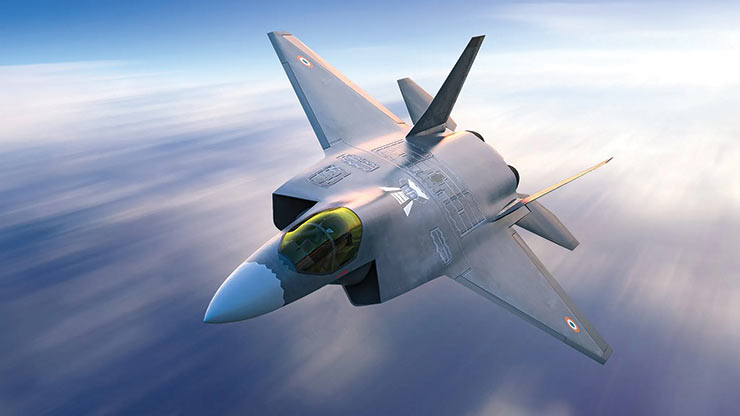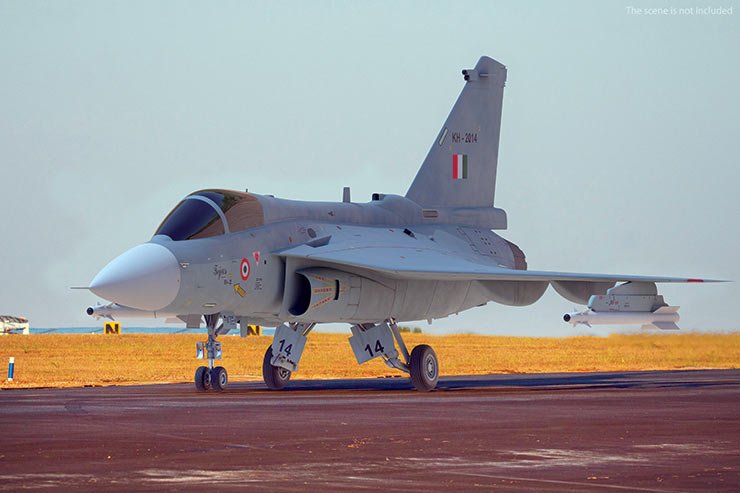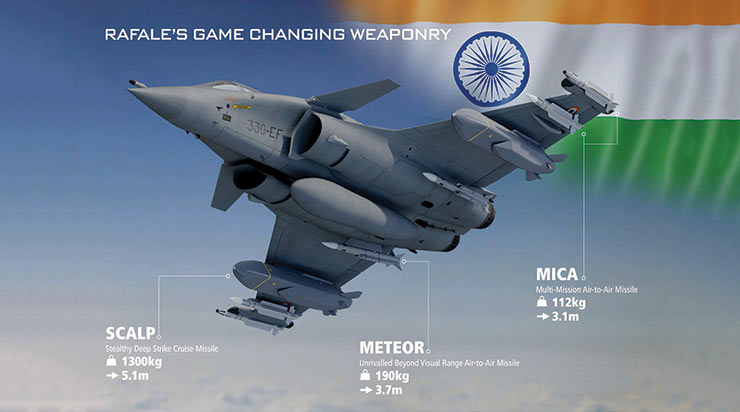In February 2023 the US brought its most advanced jet, the F-35, to India for the first time alongside the F-16 and FA-18 fighters and the B-1B bomber. This year’s US delegation at Aero India in Bengaluru was the largest in the show’s 27-year history, indicating that the Americans want to grab market share in India by offering their top aircraft.
However, it doesn’t look like the Americans have anything substantial to offer India in the area of aviation. The F-16 with its 1970s tag is clearly out of the race and the FA-18 Super Hornet is also yesterday’s technology. That leaves the F-35 stealth fighter, and its appeal lies in its stealth characteristics which most people mistakenly believe is the cloak of invisibility. However, this is far from the truth. The F-35, in fact, has numerous problems that make it unsuitable for India.
Costlier Than Oz
The F-35 has become the fighter that is more expensive than Australia! This is because the programme will eventually cost more than $1,700 billion – a sum greater than Australia’s GDP. At the same time, it is an aircraft that has been criticised by the world’s leading aviation experts as “overpriced”, “overweight” and “under-armed”. One report has claimed the only thing stealthy about the F-35 is its price.
“It’s a turkey,” declares aerospace engineer Pierre Sprey in an interview to Dutch television. Few people are as qualified to speak about fighter aircraft; Sprey was part of the US “fighter mafia” which spurred the development of the F-16 Falcon jet and the A-10 Warthog tank buster, two of the most successful aircraft in the US Air Force (USAF).
Considering that leading aviation experts have advised air forces to act with caution before they induct the F-35, any reported offers from the US should raise red flags in India. Rushing into the unknown world of stealth would be a huge mistake especially when the amounts involved could potentially bust the IAF’s budget
Winslow T. Wheeler, Director of the US’ Straus Military Reform Project, Centre for Defense information, agrees. “The F-35 is too heavy and sluggish to be successful as a fighter,” he says. “If we ever face an enemy with a serious air force we will be in deep trouble.”
Considering that leading aviation experts have advised air forces to act with caution before they induct the F-35, any reported offers from the US should raise red flags in India. Rushing into the unknown world of stealth would be a huge mistake especially when the amounts involved could potentially bust the IAF’s budget.
Stealth: Unknown Commodity
The prime reason for the aircraft’s appeal is its stealth. According to Lockheed, the F-35 will give US pilots “First Look, First Shot, First Kill” capability. Lockheed designers are betting on stealth and long-range radar to compensate for its lack of manoeuvrability. However, stealth is not really all that it is cracked up to be; it does not make the aircraft invisible.
This is because there is no such thing as a single radar in a war zone. “There are lots of radars,” Sprey explains. “And you can’t be nose-on or dead-level to every radar in the theatre. There are always going to be radars that are going to be shining up (from below) or looking from above – they can all see you.”
More importantly, air combat is more like a knife fight in which even stealth aircraft will have to come very close to the target to achieve a sure kill. The history of air combat shows that ‘within visual range’, engagements cannot be avoided altogether. In such a scenario, the F-35 will be at a distinct disadvantage because its stealth cover will be blown.
Plus, Russia has been developing radars that are able to detect stealth jets. Says the US-based Defense Industry Daily (DID): “Key radar advances are already deployed in the most advanced Russian surface-to-air missile systems, and existing IRST (infra-red scan and track) systems deployed on advanced Russian and European fighters are extending enemy detection ranges against radar-stealthy aircraft.”
Fleet Availability
Fleet availability is the key to launching a successful air war. Basically, it deals with the total number of aircraft that are fit for missions at any given time. The IAF’s air dominance fighter, the Sukhoi Su-30MKI, has a fleet availability of just 60 per cent (compared with the Western average of 70-75 per cent for equivalent fighters).
In comparison, the F-35’s availability rate is abysmal. Overall fleet-wide availability rates remain around 50 per cent – or just half the fleet available for combat. This would be suicidal for the Indian Air Force which in case is unlikely to buy more than a hundred of these fighters.
Secondly, because the US will never get into a direct shooting war with a large country such as Russia or China, it can afford to put all its eggs in the F-35 basket. India, which faces two well-armed adversaries, doesn’t have that luxury
Plus, stealth comes with a price. On the F-35, most of the maintenance is on the ‘stealth’ coating, which has to be painstakingly re-applied after each flight. The Maryland-based Naval Air Systems Command says that F-35 fighters are expected to require between 41.75 and 50.1 maintenance man-hours per flight hour, or about three times as many as most fighter aircraft currently operated by Western air forces.
Having to stay grounded for that long seriously compromises the number of sorties that an air force is able to launch. “It is a ludicrous impediment to combat. You are sitting on the ground for 50 hours fiddling on the aircraft trying to make it stealthy when it’s not stealthy anyhow,” says Sprey.
Left unsaid is the fact that 50 hours of maintenance is during ideal flying conditions. In actual combat, when the F-35 is put through the rigours of evasive manoeuvres and sustained high-speed flight, the wear and tear on the stealth coatings – plus the airframe – will surely be of a much greater scale.
Platform Complexity
Because the F-35 is basically a flying computer with massive lines of software bundled with advanced (and unproven) technologies, it would require extended weeks of maintenance by dedicated Lockheed air crews. Because some of the new technologies in the aircraft are heavily classified, certain areas of the aircraft will be no-go areas for Indian maintenance crews. This could mean either waiting for Lockheed crews to arrive onsite from the US or shipping the aircraft back to the nearest maintenance hub in Japan, assuming the Japanese crews are free to look at Indian F-35s. Imagine that happening in the middle of a war.

Impact on India’s War Strategy
First, let’s see how the US deals with the aerial component of warfare. The US has traditionally relied on massed waves of aircraft to bludgeon much smaller adversaries such as Iraq, Serbia and Libya. For instance, during both the 1991 and 2003 Gulf Wars, the Americans launched massed bombing raids (comprising over a thousand coalition aircraft) into Iraq that simply overwhelmed the country’s air defences. The Iraqi Air Force was unable to even get a good look at the enemy.
Another aspect of US air combat is to completely suppress enemy air defences before sending in attack aircraft. EA-18 Growler electronic warfare jets – armed with high-speed anti-radiation missiles – take out most of the radars, military communications systems and anti-aircraft missile batteries in the opening hours of the war. Enemy air space is virtually sanitised by the time American and allied fighters and bombers arrive. Plus, airborne warning and control systems (AWACS) and satellites provide US commanders with a god’s eye of the battlefield.
Therefore, in a scenario where massive superiority in numbers prevails plus aerial intelligence is also available on a 24/7 networked basis, the limitations of a glitch-prone fighter like the F-35 can be glossed over.
Secondly, because the US will never get into a direct shooting war with a large country such as Russia or China, it can afford to put all its eggs in the F-35 basket. India, which faces two well-armed adversaries, doesn’t have that luxury. The IAF trains hard during peacetime, but the limited fleet availability of the F-35 means Indian pilots will be sitting around for days or weeks, waiting for their jets to be serviced. Both training and morale will be impacted.
Wheeler, who has dealt with US national security issues for over three decades, lays out the implications for air forces planning to induct the F-35: “The pilots will get worse as they’ll get much less training, which is more important than any technical issue. There’ll be far fewer pilots as the whole force will have to shrink, and you will basically have a showpiece aircraft that can’t do anything. It’s useless, it’s truly monumentally useless, it will ruin any air force that uses it.”

Indigenous Option
Instead of splurging billions of dollars by importing an unproven foreign fighter, India would be better off waiting for its indigenous stealth fighter programme – the Advanced Medium Combat Aircraft or AMCA – to mature. The fifth-generation tactical deep-strike fighter can help India enhance its strategic position, maintain technological sovereignty and address emerging threats.
The Defence Research Development Organisation (DRDO) has finished the aircraft’s design and is all set to proceed to the Critical Design Review stage – a technical review to ensure that the system of an aircraft can proceed into fabrication, demonstration and test, and can meet performance requirements. The project timeline indicates the first test flight could take place in 2028.
Instead of splurging billions of dollars by importing an unproven foreign fighter, India would be better off waiting for its indigenous stealth fighter programme – the Advanced Medium Combat Aircraft or AMCA – to mature. The fifth-generation tactical deep-strike fighter can help India enhance its strategic position, maintain technological sovereignty and address emerging threats
The 25-ton AMCA is designed to excel in multirole missions, including air superiority, strike and electronic warfare. This versatility is essential in addressing a wide spectrum of modern threats effectively. The fighter boasts cutting-edge avionics, including radar systems, sensors, and communication equipment, providing superior situational awareness and combat effectiveness.
The aircraft is designed to carry a wide range of advanced weapons, including air-to-air missiles, precision-guided munitions, and standoff weapons, ensuring its effectiveness in various mission profiles. Plus, supercruise capability allows it to sustain supersonic speeds without afterburners, conserving fuel and extending operational range.
Investing in the AMCA’s development and production stimulates the domestic defence industry, fostering economic growth, creating jobs and attracting foreign investment in the defence sector. India’s pursuit of stealth reflects a broader strategy to reduce dependence on foreign arms imports. By developing and producing its advanced fighter aircraft, the country can safeguard its defence capabilities from external pressures and sanctions.
A successful AMCA programme could thus position India as a significant player in the global arms market. Many countries seek advanced, cost-effective fighter aircraft, and the AMCA could meet these demands. Therefore, having a technologically advanced stealth fighter will strengthen India’s bargaining position in geopolitical negotiations and alliances, giving it more weight on the global stage.
Tejas on Track
While the AMCA programme is still at least 10 years away from delivering a production aircraft, the IAF is relying on a mix of Sukhoi Su-30s and Rafales and the indigenous Tejas light combat aircraft to provide the bulk of its interim future fighter fleet. The Air Force brass has also accepted the adage that you fight with the best weapons you have, not with the weapons you want. From initial scepticism about a Made-in-India fighter, the IAF has been convinced by the government that it has no other option but to induct the Tejas.
The good news is that the Tejas has incrementally got better, with each iteration. In September 2023, the IAF made it clear that it would go ahead with the procurement of 100 more Tejas Mark-1A fighter jets. These will be in addition to the 83 jets ordered in February 2021 under a Rs 48,000 crore order. The IAF currently has 40 first-generation Tejas jets, which are based in the Sulur Air Base in Tamil Nadu, and plans to increase the fleet strength to 300. At just $43 million – compared with Rafale’s $115 million price tag – the Made-in-India fighter is also easy on the exchequer.

Tejas brings huge versatility to the IAF, and once inducted in sufficient numbers, it can change the shape of the battlefield. After the air dominance, Sukhois and Rafales kick in the door, and enemy air defences are further degraded by BrahMos, Nirbhay and anti-radiation missile strikes, waves of Tejas jets of varying configurations can overwhelm enemy defences. A swarm of 200 Tejas fighters can blow away the much smaller Pakistani air defence fleet assuming they are foolhardy to offer a challenge.
This was a Cold War strategy adopted by the Soviet Union during the 1970s when its fighter jets were not as advanced as comparable Western aircraft. With thousands of interceptors and attack fighters at their disposal, the Russian logic was that “quantity has a quality all its own”. The belief was that waves of coordinated attacks would pre-empt, unhinge, and paralyse the enemy.
While the AMCA programme is still at least 10 years away from delivering a production aircraft, the IAF is relying on a mix of Sukhoi Su-30s and Rafales and the indigenous Tejas light combat aircraft to provide the bulk of its interim future fighter fleet
The Tejas has become the poster child for indigenisation of arms production and the Indian defence industry’s push to develop export markets, says Salvatore Babones of Australia’s Centre for Independent Studies. “With the Tejas, India joins an elite group of countries that have demonstrated the capacity to develop and manufacture so-called fourth-generation fighters: combat aircraft characterised by electronic fly-by-wire control systems, onboard situation awareness displays, and over-the-horizon strike capabilities,” he says.
Meanwhile, HAL is developing the Tejas MK-II, a fifth-generation fighter with stealth features. Currently undergoing trials, it is set to add further muscle to the IAF’s combat fleet.
Key Takeaways
The acquisition of the AMCA and Tejas is not merely a matter of choice for the IAF; it is a strategic imperative. In an era of evolving security dynamics, technological advancements, and emerging threats, both aircraft offer India a potent tool to safeguard its sovereignty, maintain regional dominance, and contribute to global stability.
The AMCA is not just a fighter aircraft; it is a symbol of India’s commitment to securing its future and contributing to a safer neighbourhood environment. As the IAF moves forward with its acquisition plans, the homegrown fighter represents a crucial step in ensuring India’s defence readiness for decades to come.
– The writer is a globally cited defence analyst. His work has been published by leading think tanks, and quoted extensively in books on diplomacy, counter terrorism, warfare and economic development. The views expressed are of the writer and do not necessarily reflect the views of Raksha Anirveda
–The writer is a globally cited defence analyst based in New Zealand. The views expressed are of the writer and do not necessarily reflect the views of Raksha Anirveda














